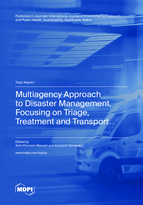Topic Menu
► Topic MenuTopic Editors


Multiagency Approach to Disaster Management, Focusing on Triage, Treatment and Transport

A printed edition is available here.
Topic Information
Dear Colleagues,
Several steps need to be considered in the management of disasters and emergencies.
Establishing command and control with the ability of communication enables sufficient collaboration and engagement of other agencies and offers a magnificent possibility for both situational assessment of the incident and the balance between available personnel and material resources and the needs for successful management of the incident. Although these steps are necessary for overall management of the incident, the medical part remains critical to the operational level of an incident. Triage, treatment, and transport of patients are vital steps in the management of the victims and influence the overall outcome of an incident. It is therefore critical to have established a guideline of how victims are triaged, treated, and transported to specialized medical facilities. These comprise vital parameters in a multiagency approach to disasters and major incidents, where several organizations with diverse backgrounds, knowledge, limitations, and abilities need to work together.
The most critical function of triage is to sort out patients in a fair, swift, medically safe, and compatible way to facilitate patients transfer from the incident site to a medical facility. However, although there are several prehospital triage models, there is no evidence for one being superior to others. Therefore, as long as the participating agencies practice a uniform type of triage, there will be no danger to patients’ medical safety. However, this is not always the case, and even within one region, various types of prehospital triage might be employed, which indicates a need for uniform triage strategies.
Treatment quality and duration at both prehospital and emergency department settings are critical for the survival of the victims. Prehospital treatment should not be time-consuming to facilitate a quick transport of the patient to the hospitals. Various guidelines provide a good foundation for professionals to act at this level; however, with the involvement of communities and immediate responders, there is a need for the review of the current guidelines to discuss the extent of immediate responders’ participation in the primary management of injured and victims.
Transport and logistics of victims remain another core area that needs to be discussed. In most countries, the number of medically equiped vehicles is insufficient either due to the limited number of unoccupied vehicles or the lack of staff and ambulances. Ground ambulances may also encounter various difficulties due to traffic congestion. Air ambulances and helicopters represent other alternatives, but many countries lack the necessary financial means or favorable geography for the use of these modalities.
The aim of this issue is to bring researchers and practitioners together to discuss and describe issues and solutions regarding evidence-based management of disasters and major incidents victims with particular focus on triage, treatment, and transport. Special considerations should be given to CBRNE events and their influence on the assessment and management of the victims.
Prof. Dr. Amir Khorram-Manesh
Dr. Krzysztof Goniewicz
Topic Editors
Keywords
- triage
- treatment
- transport
- prehospital
- disasters
- major incidents
Participating Journals
| Journal Name | Impact Factor | CiteScore | Launched Year | First Decision (median) | APC |
|---|---|---|---|---|---|

International Journal of Environmental Research and Public Health
|
- | 5.4 | 2004 | 29.6 Days | CHF 2500 |

Sustainability
|
3.9 | 5.8 | 2009 | 18.8 Days | CHF 2400 |

Healthcare
|
2.8 | 2.7 | 2013 | 19.5 Days | CHF 2700 |

Safety
|
1.9 | 3.3 | 2015 | 29.6 Days | CHF 1800 |

MDPI Topics is cooperating with Preprints.org and has built a direct connection between MDPI journals and Preprints.org. Authors are encouraged to enjoy the benefits by posting a preprint at Preprints.org prior to publication:
- Immediately share your ideas ahead of publication and establish your research priority;
- Protect your idea from being stolen with this time-stamped preprint article;
- Enhance the exposure and impact of your research;
- Receive feedback from your peers in advance;
- Have it indexed in Web of Science (Preprint Citation Index), Google Scholar, Crossref, SHARE, PrePubMed, Scilit and Europe PMC.

